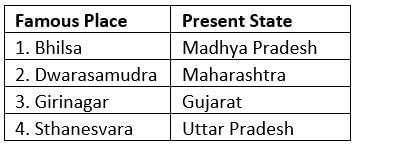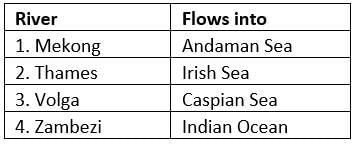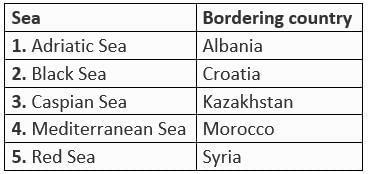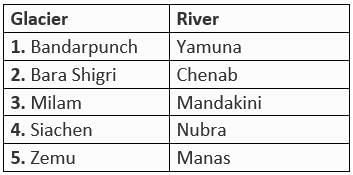Test: UPSC Prelims (Past Year Questions) Geography 2015-20 - 1 - UPSC MCQ
30 Questions MCQ Test - Test: UPSC Prelims (Past Year Questions) Geography 2015-20 - 1
What are the advantages of fertigation in agriculture?
1. Controlling the alkalinity of irrigation water is possible.
2. Efficient application of Rock Phosphate and all other phosphatic fertilizers is possible.
3. Increased availability of nutrients to plants is possible.
4. Reduction in the leaching of chemical nutrients is possible.
Select the correct answer using the code given below:
(2020)
Consider the following minerals:
1. Bentonite
2. Chromite
3. Kyanite
4. Sillimanite
In India, which of the above is/are officially designated as major minerals?
(2020)
With reference to Ocean Mean Temperature(OMT), which of the following statements is/are correct?
1. OMT is measured upto a depth of 26 degree Celsius isotherm which is 129 meters in the south-western Indian Ocean during January-March.
2. OMT collected during January-march can be used in assessing whether the amount of rainfall in monsoon will be less or more than a certain long-term mean.
Select the correct answer using the code given below:
(2020)
Siachen Glacier is situated to the
(2020)
With references to the history of India, consider the following pairs:

Which of the pairs given above is/are correctly matched?
(2020)
Consider the following statements:
1. 36% of India’s districts are classified as “overexploited” or “critical” by the Central Ground Water Authority(CGWA).
2. CGWA was formed under the Environment (Protection) Act.
3. India has the largest area under groundwater irrigation in the world.
Which of the statements given above is/are correct?
(2020)
Consider the following statements:
1. Jet Streams occur in the Northern Hemisphere only.
2. Only some cyclones develop an eye.
3. The temperature inside the eye of a cyclone is nearly 10 degrees Celsius lesser than that of the surroundings.
Which of the statements given above is/are correct?
(2020)
What is/are the advantage/advantages of zero tillage in agriculture?
1. Sowing of wheat is possible without burning the residue of the previous crop.
2. Without the need for the nursery of rice saplings, direct planting of paddy seeds in the wet soil is possible.
3. Carbon sequestration in the soil is possible.
Select the correct answer using the code given below:
(2020)
“The crop is subtropical in nature. A hard frost is injurious to it. It requires at least 210 frost-free days and 50 to 100 centimeters of rainfall for its growth. A light well-drained soil capable of retaining moisture is ideally suited for the cultivation of the crop.” Which one of the following is that crop?
(2020)
With reference to the current trends in the cultivation of sugarcane in India, consider the following statements:
1. A substantial saving in seed material is made when ‘bud chip settlings are raised in a nursery and transplanted in the main field.
2. When direct planting of setts is done, the germination percentage is better with single-budded setts as compared to setts with many buds.
3. If bad weather conditions prevail when setts are directly planted, single-budded setts have better survival as compared to large sets.
4. Sugarcane can be cultivated using settlings prepared from tissue culture.
Which of the statements given above is/are correct?
(2020)
In the context of India, which of the following is/are considered to be practice(s) of eco-friendly agriculture?
1. Crop diversification
2. Legume intensification
3. Tensiometer uses
4. Vertical farming
Which of the statements given above is/are correct?
(2020)
Consider the following pairs:

Which of the statements given above is/are correct?
(2020)
With reference to the cultivation of Kharif crops in India in the last five years, consider the following statements:
1. Area under rice cultivation is the highest.
2. Area under the cultivation of jowar is more than that of oilseeds.
3. Area of cotton cultivation is more than that of sugarcane.
4. Area under sugarcane cultivation has steadily decreased.
Which of the statements given above are correct?
(2019)
Recently, scientists observed the merger of giant ‘blackholes’ billions of light-years away from the Earth. What is the significance of this observation?
(2019)
Consider the following pairs

Which of the pairs given above are correctly matched?
(2019)
In the context of which of the following do some scientists suggest the use of cirrus cloud thinning technique and the injection of sulphate aerosol into stratosphere?
(2019)
On 21st June, the Sun
(2019)
What is common to the places known as Aliyar, Isapur, and Kangsabati?
(2019)
Why are dewdrops not formed on a cloudy night?
(2019)
Consider the following pairs:

Which of the pair given above are correctly matched?
(2019)
(a) 1, 2 and 4 only
(b) 1, 3 and 4 only
(c) 2 and 5 only
(d) 1, 2, 3, 4 and 5
Consider the following pairs:

Which of the pairs given above are correctly matched?
(2019)
Which of the following has/have shrunk immensely/dried up in the recent past due to human activities?
(2018)
1. Aral Sea
2. Black Sea
3. Lake Baikal
Select the correct answer using the codes given below:
Consider the following statements:
1. The Earth’s magnetic field has reversed every few hundred thousand years.
2. When the Earth was created more than 4000 million years ago, there was 54% oxygen and no carbon dioxide.
3. When living organisms originated, they modified the early atmosphere of the Earth.
Which of the statements given above is/are correct?
(2018)
With reference to the circumstances in Indian agriculture, the concept of “Conservation Agriculture” assumes significance” Which of the following fall under the Conservation Agriculture?
1. Avoiding the monoculture practices
2. Adopting minimum tillage
3. Avoiding the cultivation of plantation crops
4. Using crop residues to cover soil surface
5. Adopting spatial and temporal crop sequencing/crop rotations
Select the correct answer using the code given below:
(2018)
The term “sixth mass extinction/sixth extinction” is often mentioned in the news in the context of the discussion of
(2018)
Which one of the following is an artificial lake?
(2018)
Which of the following is/are the possible consequence/s of heavy sand mining in riverbeds?
(2018)
1. Decreased salinity in the river
2. Pollution of groundwater
3. Lowering of the water-table
Select the correct answer using the code given below:
With reference to agricultural soils, consider the following statements:
1. A high content of organic matter in soil drastically reduces its water holding capacity.
2. Soil does not play any role in the sulphur cycle.
3. Irrigation over a period of time can contribute to the salinization of some agricultural lands.
Which of the statements given above is/are correct?
(2018)
Consider the following statements:
1. The Barren Island volcano is an active volcano located in the Indian Territory.
2. Barren Island lies about 140 km east of Great Nicobar
3. The last time the Barren Island volcano erupted was in 1991 and it has remained inactive since then.
Which of the statements given above is/are correct?
(2018)
Consider the following pairs:

Which of the pairs given above are correctly matched?
(2018)














